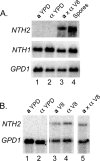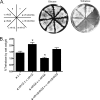Developmental cell fate and virulence are linked to trehalose homeostasis in Cryptococcus neoformans
- PMID: 25001408
- PMCID: PMC4187628
- DOI: 10.1128/EC.00152-14
Developmental cell fate and virulence are linked to trehalose homeostasis in Cryptococcus neoformans
Abstract
Among pathogenic environmental fungi, spores are thought to be infectious particles that germinate in the host to cause disease. The meningoencephalitis-causing yeast Cryptococcus neoformans is found ubiquitously in the environment and sporulates in response to nutrient limitation. While the yeast form has been studied extensively, relatively little is known about spore biogenesis, and spore germination has never been evaluated at the molecular level. Using genome transcript analysis of spores and molecular genetic approaches, we discovered that trehalose homeostasis plays a key role in regulating sporulation of C. neoformans, is required for full spore viability, and influences virulence. Specifically, we found that genes involved in trehalose metabolism, including a previously uncharacterized secreted trehalase (NTH2), are highly overrepresented in dormant spores. Deletion of the two predicted trehalases in the C. neoformans genome, NTH1 and NTH2, resulted in severe defects in spore production, a decrease in spore germination, and an increase in the production of alternative developmental structures. This shift in cell types suggests that trehalose levels modulate cell fate decisions during sexual development. We also discovered that deletion of the NTH2 trehalase results in hypervirulence in a murine model of infection. Taken together, these data show that the metabolic adaptations that allow this fungus to proliferate ubiquitously in the environment play unexpected roles in virulence in the mammalian host and highlight the complex interplay among the processes of metabolism, development, and pathogenesis.
Copyright © 2014, American Society for Microbiology. All Rights Reserved.
Figures






Similar articles
-
Characterization and regulation of the trehalose synthesis pathway and its importance in the pathogenicity of Cryptococcus neoformans.Infect Immun. 2006 Oct;74(10):5877-87. doi: 10.1128/IAI.00624-06. Infect Immun. 2006. PMID: 16988267 Free PMC article.
-
Isolation and characterization of Cryptococcus neoformans spores reveal a critical role for capsule biosynthesis genes in spore biogenesis.Eukaryot Cell. 2009 Apr;8(4):595-605. doi: 10.1128/EC.00352-08. Epub 2009 Jan 30. Eukaryot Cell. 2009. PMID: 19181873 Free PMC article.
-
Spores as infectious propagules of Cryptococcus neoformans.Infect Immun. 2009 Oct;77(10):4345-55. doi: 10.1128/IAI.00542-09. Epub 2009 Jul 20. Infect Immun. 2009. PMID: 19620339 Free PMC article.
-
Central Role of the Trehalose Biosynthesis Pathway in the Pathogenesis of Human Fungal Infections: Opportunities and Challenges for Therapeutic Development.Microbiol Mol Biol Rev. 2017 Mar 15;81(2):e00053-16. doi: 10.1128/MMBR.00053-16. Print 2017 Jun. Microbiol Mol Biol Rev. 2017. PMID: 28298477 Free PMC article. Review.
-
Profiling a killer, the development of Cryptococcus neoformans.FEMS Microbiol Rev. 2012 Jan;36(1):78-94. doi: 10.1111/j.1574-6976.2011.00286.x. Epub 2011 Jul 4. FEMS Microbiol Rev. 2012. PMID: 21658085 Free PMC article. Review.
Cited by
-
VdPT1 Encoding a Neutral Trehalase of Verticillium dahliae Is Required for Growth and Virulence of the Pathogen.Int J Mol Sci. 2023 Dec 25;25(1):294. doi: 10.3390/ijms25010294. Int J Mol Sci. 2023. PMID: 38203466 Free PMC article.
-
In silico analysis and a comparative genomics approach to predict pathogenic trehalase genes in the complete genome of Antarctica Shigella sp. PAMC28760.Virulence. 2022 Dec;13(1):1502-1514. doi: 10.1080/21505594.2022.2117679. Virulence. 2022. PMID: 36040103 Free PMC article.
-
Trehalase plays a role in macrophage colonization and virulence of Burkholderia pseudomallei in insect and mammalian hosts.Virulence. 2017 Jan 2;8(1):30-40. doi: 10.1080/21505594.2016.1199316. Epub 2016 Jul 1. Virulence. 2017. PMID: 27367830 Free PMC article.
-
Trehalose metabolism: A sweet spot for Burkholderia pseudomallei virulence.Virulence. 2017 Jan 2;8(1):5-7. doi: 10.1080/21505594.2016.1216295. Epub 2016 Jul 26. Virulence. 2017. PMID: 27540767 Free PMC article. No abstract available.
-
Transcriptional Dynamics of Genes Purportedly Involved in the Control of Meiosis, Carbohydrate, and Secondary Metabolism during Sporulation in Ganoderma lucidum.Genes (Basel). 2021 Mar 29;12(4):504. doi: 10.3390/genes12040504. Genes (Basel). 2021. PMID: 33805512 Free PMC article.
References
Publication types
MeSH terms
Substances
Grants and funding
LinkOut - more resources
Full Text Sources
Other Literature Sources
Molecular Biology Databases

